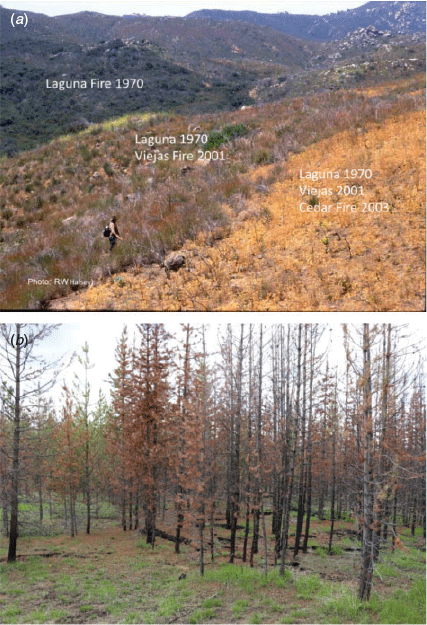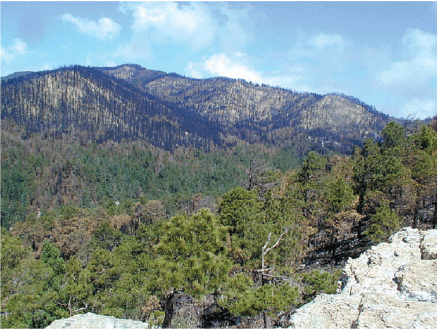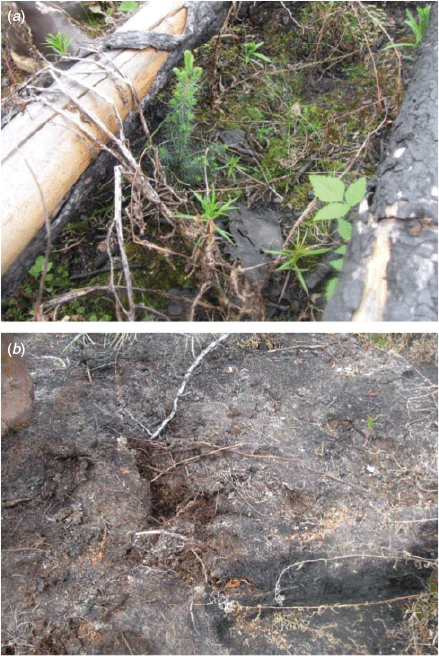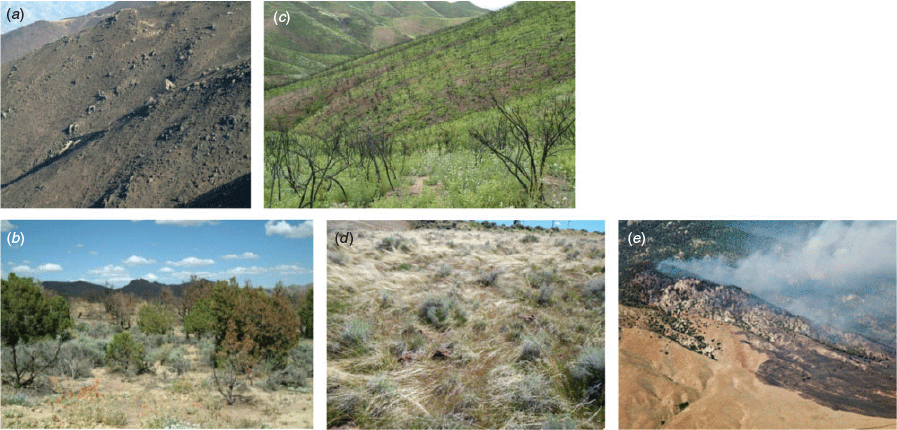Distinguishing disturbance from perturbations in fire-prone ecosystems
Jon E. Keeley A B D and Juli G. Pausas CA US Geological Survey, Western Ecological Research Center, Sequoia–Kings Canyon Field Station, Three Rivers, CA 93271, USA.
B Department of Ecology and Evolutionary Biology, University of California, Los Angeles, CA 90095, USA.
C Centro de Investigaciones sobre Desertificación, Consejo Superior de Investigaciones Cientíticas (CIDE-CSIC), Carretera CV-315, km 10.7, Montcada, Valencia, Spain.
D Corresponding author. Email: jon_keeley@usgs.gov
International Journal of Wildland Fire 28(4) 282-287 https://doi.org/10.1071/WF18203
Submitted: 23 November 2018 Accepted: 21 March 2019 Published: 18 April 2019
Abstract
Fire is a necessary ecosystem process in many biomes and is best viewed as a natural disturbance that is beneficial to ecosystem functioning. However, increasingly, we are seeing human interference in fire regimes that alters the historical range of variability for most fire parameters and results in vegetation shifts. Such perturbations can affect all fire regime parameters. Here, we provide a brief overview of examples where anthropogenically driven changes in fire frequency, fire pattern, fuels consumed and fire intensity constitute perturbations that greatly disrupt natural disturbance cycles and put ecosystems on a different trajectory resulting in type conversion. These changes are not due to fire per se but rather anthropogenic perturbations in the natural disturbance regime.
Additional keywords: human impacts, invasive species, patch dynamics, type conversion.
Introduction
Fire has historically been viewed as an ecological disturbance, much like hurricanes, floods and animal trampling of natural ecosystems. Increasingly though, humans are playing a role in determining the outcomes of disturbances. Addressing this issue, White and Pickett (1985) made the important distinction between natural disturbances and perturbations, defined as departures from the normal state, usually as the result of human interference.
In many biomes, fire is an essential ecosystem process (Bond and van Wilgen 1996), and it has been so over long geological time scales (Pausas and Keeley 2009). In these fire-prone ecosystems, natural fire regimes are conducive to the resilience of these communities. However, increasingly, we are seeing human interference in fire regimes that alters the historical range of variability for most fire parameters and results in vegetation shifts.
Natural disturbances in fire-prone ecosystems are characterised by their historical range of variability in frequency, severity and patchiness of fires (Safford et al. 2012). Portraying the conditions sufficient for fires has traditionally been depicted in a triangle with axes of fuel, climate and ignitions. However, to understand fire regimes, we require a fourth axis, fuel structure (Keeley et al. 2012). Fire regimes follow from the nexus of community productivity, which must produce sufficient fuel connectivity to carry fire, seasonality of climate at an annual, decadal or longer scale where biomass is converted to available fuels, a predictable ignition source, and perhaps the strongest controller of fire regimes, fuel structure. Indeed, the shorthand expression of regimes is commonly labelled by the fuels consumed, i.e. ground fires, surface fires and crown fires.
In terms of fire regime, fire frequency is critically important to vegetation response and it is typically defined in absolute time, but it is sometimes more useful to consider frequency as fire periodicity relative to the life history of the dominant species. A distinctly different fire regime parameter is the patchiness of burning, which can vary markedly from massive landscape-scale chaparral fires (Fig. 1a) and boreal forest crown fires, to patchy burns in Great Basin sage scrub (Fig. 1b) as well as in many western USA coniferous forests with a mix of surface and crown fires (Stephens et al. 2015). Fuels consumed can be subsurface peat moss, surface fuels of either herbaceous plants or dead leaves and branches, or canopy fuels of live and dead woody plants, either shrubs or trees. Fire intensity is most relevant in terms of fire severity, i.e. impact on dominant species (e.g. Keeley 2009).
Of course, fire regime parameters do not act independently, e.g. frequency affects intensity, which in turn affects fuels consumed, but focusing on impacts of specific parameters has heuristic value. Here, we offer examples of how human-caused perturbations of each of these fire regime parameters can lead to an abrupt state shift, with the new vegetation state having markedly different functional attributes. Those regime shifts can disrupt the ecosystem services provided by fire (Pausas and Keeley 2019).
Perturbations of the fire regime
Perturbation of any fire regime parameter has the potential for diminishing ecosystem resilience. Thus, the critical factor determining system resilience is not disturbance per se but rather perturbations of fire regime parameters. There are clear examples of how human-linked perturbations of all fire regime parameters have led to ecosystem changes.
Alterations in fire frequency
Many fire-prone ecosystems are sensitive to the frequency of burning. For example, California crown fire chaparral shrublands recover following long-interval fire-free periods entirely by regeneration from soil-stored seed banks and basal resprouts. Thus, regeneration is endogenous and fire size is largely irrelevant to recovery (e.g. Fig. 1c); however, chaparral ecosystems are sensitive to fire frequency. Soil-stored seed banks require decades to replenish and when fire frequency is increased by accelerated anthropogenic burning, recovery of many species is jeopardised and invasion by highly competitive non-native grasses is a significant threat (Fig. 2a). Further, invasive grasses create conditions favouring repeat fires at short intervals and this feedback process leads to further fire regime perturbations (Keeley et al. 2012).

|
Other crown fire ecosystems such as lodgepole pine (Pinus contorta) forests are likewise threatened when fire frequency is higher than historical norms. In the past, these low-productivity forests have burned at intervals of one to several centuries; however, shorter intervals between fires may drastically diminish forest recruitment (Fig. 2b). Detailed examination of this phenomenon suggests that short-interval fires reduce recruitment 99% over long-interval fires, putting the system on a trajectory for type conversion to a non-forested ecosystem (Turner et al. 2018). In this forest type, fire is critically important to stimulating the opening of serotinous cones and triggering establishment of a new cohort of seedlings. However, when the historical fire regime is perturbed by short fire intervals, this disturbance diminishes recruitment by burning before sufficient seed pools have formed as well as increasing the exposure of cones to high temperatures in the more diminutive trees. In these lodgepole forests, lightning remains the dominant ignition source and we hypothesise that shorter intervals are likely the result of anthropogenically induced global warming that has increased rate of fuel accumulation and decreased fuel moisture in young stands.
Thus, ecosystems adapted to fires are not adapted to all fire frequencies, and both shrublands and some forest types may be sensitive to anthropogenically caused increase in fire frequency. Fire per se is not a threat to ecosystem resilience, but in this instance, it is anthropogenically increased fire frequency, outside the historical range of variation that is a major perturbation to these fire-adapted ecosystems.
Alterations in landscape burning patterns
Patch dynamics were a central focus of White and Pickett’s (1985) discussion of disturbance and perturbations. Contrasting Great Basin sage scrub with California chaparral is a good illustration of the importance of this phenomenon. Sage scrub has historically burned in very patchy patterns where stands of unburned vegetation were frequently interspersed within burn perimeters (Fig. 1b). This appears to be a very crucial component of recovery because life history characteristics of dominants suggest recovery depends on patchy fires. Although this interior sage scrub community regularly burns in crown fires similar to California chaparral, none of the dominant species resprout or maintain soil or aerial seed banks such as seen in chaparral (Fig. 1c). Rather, recruitment is dependent on metapopulations that include patches of unburned vegetation, which disperse propagules into adjacent burned areas. In the past, patchy burns were naturally maintained by the open nature of these scrub stands interspersed with native forbs and perennial grasses (Fig. 1b). However, owing to a history of management with excessive prescribed burning and livestock grazing (Keeley et al. 2009), the region has been aggressively invaded by annual cheatgrass (Bromus tectorum), which has produced a contiguous fuel source (Fig. 2d). This has resulted in larger contiguous burns, greatly altering the patch dynamics (Fig. 1e), and diminishing opportunities for natural recruitment owing to the excessively long distances for recolonisation by sage scrub natives.
Thus, ecosystems adapted to crown fires are not adapted to all patterns of burning and some may be sensitive to large contiguous burns. Unlike chaparral, which is threatened by high fire frequency, Great Basin sage scrub is threatened more by patch size of fires, a perturbation of the natural fire regime resulting from anthropogenically driven cheatgrass invasion.
Alterations in fuels consumed
On moderately high productivity sites such as mixed conifer forests in the western USA, trees are capable of outgrowing surface fuels. Volume of these surface fuels has been kept at a low level by high fire frequency spawned by lightning ignitions; thus, typically there is a fuel gap between surface fuels and canopy fuels leading to understorey burning (Allen et al. 2002). Historically, these forests have burned under frequent (10–20-year return intervals) low-intensity surface fires, fuelled typically by surface litter, but by herbaceous fuels on more open savanna sites (Swetnam and Baisan 2003). Occasionally pockets of surface fuels and overstocked recruitment have generated sufficient fuels for passive crown fires that produced gaps in the forest canopy. These localised gaps have played a critical role in the regeneration of some forest dominants such as ponderosa pine (Pinus ponderosa), which requires localised gaps for recruitment: high light, low surface litter and proximity of parent seed trees (Keeley and Stephenson 2000).
However, because of the combination of burning conditions in these forests, i.e. lightning-ignited fires under moderate weather conditions fed by surface fuels, fire suppression policy has been highly successful and in many western forests can be equated with fire exclusion for a century or longer (Safford and Van de Water 2014). As a consequence, surface fuels and standing ladder fuels have accumulated beyond the historical range of variation and produced conditions where fires readily spread into tree canopies, resulting in large contiguous crown fires (Fig. 3). This represents a fire perturbation with huge ecosystem consequences because the speed of ponderosa pine regeneration is dependent on distance between high-intensity burned gaps and parent seed trees. Under historical conditions of surface fires and small patches of crown fires, there has usually been a ready source of seeds within dispersal distance, but these anomalously large crown fires greatly increase the distance between parent seed trees and safe sites for seedling recruitment (Shive et al. 2018), and thus ponderosa pine recruitment is nil over much of the landscape it formerly dominated. Such disturbed forests are often put on a trajectory of type conversion to other vegetation types (Walker et al. 2018).

|
Fire per se is not the issue here but rather the perturbation resulting from fire suppression, which has altered the fuels being consumed. This is the proximal cause although it is acknowledged that the ultimate cause is a reduction in fire frequency due to effective fire suppression.
Alterations in fire intensity
Boreal forests at high latitudes are experiencing more intense fires apparently due to anthropogenically driven global warming. The primary impact is changes in post-fire substrates. Typically, moss substrate survives fires and is conducive to spruce regeneration (Fig. 4a). However, as temperatures increase in the higher latitudes, fires are of greater severity, sufficient to disintegrate the moss substrate (Fig. 4b), favouring hardwood regeneration over spruce (Johnstone and Chapin 2006). Owing to global warming, these ecosystems are on a trajectory of change leading to a disruption in the fire severity component of the fire regime (Johnstone et al. 2010).

|
Thus, perturbation in this fire regime has produced a change in landscape-scale patterns of burning in ways that greatly reduce the recovery of the indigenous ecosystem after fire put the system on a trajectory of type conversion.
Why does it matter?
Some may be inclined to dismiss this argument as simply a matter of semantics that does not rise to the level of a significant problem. However, Johns and DellaSala (2017) make a convincing case for how conservation problems may be misled by language. They remind us of George Orwell’s demonstration that imprecisely used language can obfuscate messages in ways that fail to convey important information.
One example that comes to mind is a recent paper by Kimball et al. (2018) who set out to sort out the most important disturbances in a nature reserve in southern California. Using a long-term monitoring dataset, they found sage scrub shrublands recovered after fire and concluded fire was not a threat on this landscape. Instead, other parameters such as drought and invasive plants were far more important disturbances. However, what they demonstrated was that the sage scrub plant community recovered fine after a single fire during their 10-year dataset, which is potentially within the natural fire frequency for this type. Although not discounting the importance of climate or invasives, there is widespread evidence in this region that accelerated fire frequency, greatly outside the natural fire regime, is perhaps the major threat to ecosystem stability in the region (Safford and Van de Water 2014). In other words, the real threat is not the disturbance caused by fire per se but rather perturbations in fire frequency, and long-term monitoring that captures a single fire will not necessarily address that issue.
The concept of distinguishing between disturbances and perturbations is likely of value in understanding other ecological situations. It is similar to the distinction Pavlovic (1994) made, which he described as concordant vs discordant disturbances. Of course, there are biomes where fire is not a natural ecosystem process, and in these cases, we should consider fire itself to be a perturbation. Examples include the invasion of grasses into tropical woodlands (D’Antonio and Vitousek 1992) or buffelgrass invasion in Sonoran Desert saguaro communities in the south-western USA (Olsson et al. 2012).
Conclusions
Disturbances such as fire generate dynamics maintaining the functionality and the services of the ecosystems, whereas perturbations in fire regimes often shift vegetation state and thus there is a change in the functionality of the ecosystem. We believe that it is critically important to recognise the threat to ecosystem resilience in fire-dependent ecosystems is not fire per se but rather perturbations in the fire regime. Fire is best viewed as a natural ecosystem process and disruption of ecosystem processes begins with perturbation of the natural fire regime. Such perturbations can affect all fire regime parameters. Changes in fuels consumed may greatly alter forest recovery by eliminating natural sources of regeneration. Changes in frequency may diminish recovery time and create repeat fires before dominant species have had time to recover seed banks. Anthropogenically driven climate change can alter fire intensity in ways that disturb the natural recovery process. Invasive species can change fuel continuity and greatly alter burning patterns, which can be detrimental to the recovery of natural systems. These examples are of heuristic value but it needs to be appreciated that there are multiple impacts from disturbances that affect more than a single fire regime parameter. Many examples of how these interact could be proposed but see Enright et al. (2015) for a nicely framed conceptual model of how regime shifts may interact with forces such as climate change.
Conflicts of interest
The authors declare that they have no conflicts of interest.
Acknowledgements
We thank Bob Keane who got one of us into thinking about this issue from his invitation to speak at the 2018 Continuum Conference in Missoula, MT. Also, we acknowledge early discussions with Jan van Wagtendonk who long held that fire was a natural ecosystem process, and William Bond’s 1995 book that first posed the problem of how fire was long misunderstood in the early development of theory in ecology. This research did not receive any specific funding.
References
Allen CD, Savage M, Falk DA, Suckling KF, Swetnam TW, Schulke T, Stacey PB, Morgan P, Hoffman M, Klingel JT (2002) Ecological restoration of south-western ponderosa pine ecosystems: a broad perspective. Ecological Applications 12, 1418–1433.| Ecological restoration of south-western ponderosa pine ecosystems: a broad perspective.Crossref | GoogleScholarGoogle Scholar |
Bond WJ, van Wilgen BW (1996) ‘Fire and plants.’ (Chapman & Hall: New York, NY, USA)
D’Antonio CM, Vitousek PM (1992) Biological invasions by exotic grasses, the grass/fire cycle, and global change. Annual Review of Ecology and Systematics 23, 63–87.
| Biological invasions by exotic grasses, the grass/fire cycle, and global change.Crossref | GoogleScholarGoogle Scholar |
Enright NJ, Fontaine JB, Bowman DMJS, Bradstock RA, Williams RJ (2015) Interval squeeze: altered fire regimes and demographic responses interact to threaten woody species persistence as climate changes. Frontiers in Ecology and the Environment 13, 265–272.
| Interval squeeze: altered fire regimes and demographic responses interact to threaten woody species persistence as climate changes.Crossref | GoogleScholarGoogle Scholar |
Johns D, DellaSala DA (2017) Caring, killing, euphemism and George Orwell: how language choice undercuts our mission. Biological Conservation 211, 174–176.
| Caring, killing, euphemism and George Orwell: how language choice undercuts our mission.Crossref | GoogleScholarGoogle Scholar |
Johnstone JF, Chapin FS (2006) Effects of soil burn severity on post-fire tree recruitment in boreal forest. Ecosystems 9, 14–31.
Johnstone JF, Hollingsworth TN, Chapin FS, Mack MC (2010) Changes in fire regime break the legacy lock on successional trajectories in Alaskan boreal forest. Global Change Biology 16, 1281–1295.
Keeley JE (2009) Fire intensity, fire severity and burn severity: a brief review and suggested usage. International Journal of Wildland Fire 18, 116–126.
| Fire intensity, fire severity and burn severity: a brief review and suggested usage.Crossref | GoogleScholarGoogle Scholar |
Keeley JE, Stephenson NL (2000) Restoring natural fire regimes in the Sierra Nevada in an era of global change. In ‘Wilderness science in a time of change conference, Vol. 5’. (Eds DN Cole, SF McCool, J O’Loughlin). USDA Forest Service, Rocky Mountain Research Station, Proceedings RMRS-P-15, pp. 255–265. (Fort Collins, CO, USA)
Keeley JW, Aplet GH, Christensen NL, Conard SG, Johnson EA, Omi PN, Peterson DL, Swetnam TW (2009) Ecological foundations for fire management in North American forest and shrubland ecosystems. USDA Forest Service, Pacific Northwest Research Station, General Technical Report, PNW-GTR-779. (Corvallis, OR, USA)
Keeley JE, Bond RA, Bradstock RA, Pausas JG, Rundel PW (2012) ‘Fire in mediterranean climate ecosystems: ecology, evolution and management’. (Cambridge University Press: Cambridge, UK)
Kimball S, Principe Z, Deutschman D, Strahm S, Huxman TE, Lulow M, Balazs K (2018) Resistance and resilience: ten years of monitoring shrub and prairie communities in Orange County, CA, USA. Ecosphere 9, e02212
| Resistance and resilience: ten years of monitoring shrub and prairie communities in Orange County, CA, USA.Crossref | GoogleScholarGoogle Scholar |
Olsson AD, Betancourt J, McClaren MP, Marsh SE (2012) Sonoran Desert Ecosystem transformation by a C4 grass without the grass/fire cycle. Diversity and Distributions 18, 10–21.
Pausas JG, Keeley JE (2009) A burning story: the role of fire in the history of life. Bioscience 59, 593–601.
| A burning story: the role of fire in the history of life.Crossref | GoogleScholarGoogle Scholar |
Pausas JG, Keeley JE (2019) Wildfires as an ecosystem service. Frontiers in Ecology and the Environment , in press.
Pavlovic NB (1994) Disturbance-mediated persistence of rare plants: restoration implications. In ‘Recovery and restoration of endangered species’. (Eds ML Bowles, C Whelan) pp. 159–193. (Cambridge University Press: Cambridge, UK)
Safford HD, Van de Water KM (2014) Using fire return interval departure (FRID) analysis to map spatial and temporal changes in fire frequency on national forest lands in California. USDA Forest Service, Pacific Southwest Research Station, PSW Research Paper PSW-RP-266. (Albany, CA, USA)
Safford HD, Hayward G, Heller N, Wiens JA (2012) Climate change and historical ecology: can the past still inform the future? In ‘Historical environmental variation in conservation and natural resource management’. (Eds JA Wiens, G Hayward, HD Safford, CM Giffen) pp. 46–62. (John Wiley and Sons: New York, NY, USA)
Shive KL, Preisler HK, Welch KR, Safford HD, Butz RJ, O’Hara KL, Stephens SL (2018) From the stand scale to the landscape scale: predicting the spatial patterns of forest regeneration after disturbance. Ecological Applications 28, 1626–1639.
| From the stand scale to the landscape scale: predicting the spatial patterns of forest regeneration after disturbance.Crossref | GoogleScholarGoogle Scholar | 29809291PubMed |
Stephens SL, Lydersen JM, Collins BM, Fry DL, Meyer MD (2015) Historical and current landscape-scale ponderosa pine and mixed-conifer forest structure in the southern Sierra Nevada. Ecosphere 6, 79
| Historical and current landscape-scale ponderosa pine and mixed-conifer forest structure in the southern Sierra Nevada.Crossref | GoogleScholarGoogle Scholar |
Swetnam TW, Baisan CH (2003) Tree-ring reconstructions of fire and climate history in the Sierra Nevada and south-western United States. In ‘Fire and climatic change in temperate ecosystems of the western Americas’. (Eds TT Veblen, WL Baker, G Montenegro, TW Swetnam) pp. 158–195. (Springer: New York, NY, USA)
Turner MG, Harvey BJ, Hansen WD, Braziunas KH (2018) Changing fire regimes and resilience of lodgepole pine forests in Yellowstone. Abstract. In ‘Contributed Talks: 103rd Annual Meeting Ecological Society of America’, 5–10 August 2018, New Orleans, LA, USA. Available at https://esa.org/neworleans/newsroom/program-tips/fire/ [Verified 6 April 2019]
Walker RB, Coop JD, Parks SA, Trader L (2018) Fire regimes approaching historic norms reduce wildfire‐facilitated conversion from forest to non‐forest. Ecosphere 9, e02182
| Fire regimes approaching historic norms reduce wildfire‐facilitated conversion from forest to non‐forest.Crossref | GoogleScholarGoogle Scholar |
White PS, Pickett STA (1985) Natural disturbance and patch dynamics: an introduction. In ‘The ecology of natural disturbance and patch dynamics’. (Eds STA Pickett, PS White) pp. 3–13. (Academic Press: New York, NY, USA)



